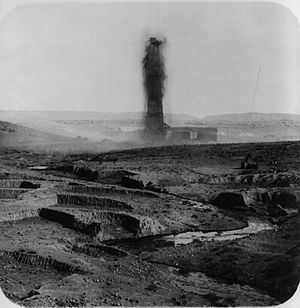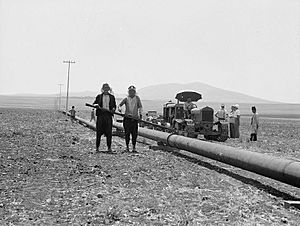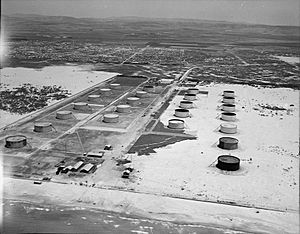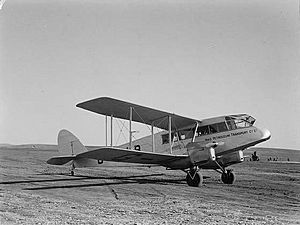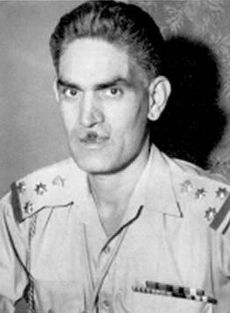Iraq Petroleum Company facts for kids
 |
|
|
Native name
|
شركة نفط العراق
Türkiye Petrol Şirketi |
|---|---|
| Consortium | |
| Industry | Oil exploration and production |
| Fate | Nationalised in 1972a |
| Predecessor | Turkish Petroleum Company |
| Successor | Iraq National Oil Company |
| Founded | 1929 |
| Founders |
|
| Headquarters |
London
,
United Kingdom
|
|
Areas served
|
|
| Owners |
|
Footnotes / references
|
|
The Iraq Petroleum Company (IPC) was an oil company that controlled almost all oil exploration and production in Iraq for many years. It was formed in 1925 and operated until 1961. The company was owned by some of the world's biggest oil companies. Its main office was in London, England.
In June 1972, the Iraqi government took control of the IPC. Its operations were then managed by the Iraq National Oil Company. Today, the Iraq Petroleum Company still exists on paper, but it doesn't actually do any oil business. However, one related company, the Abu Dhabi Petroleum Company (ADPC), still operates with its original owners.
The Iraq Petroleum Group was a collection of companies. They played a big part in finding and developing oil in other parts of the Middle East outside of Iraq.
History of the Iraq Petroleum Company
How the Turkish Petroleum Company Started
The company that became the Iraq Petroleum Company was first called the Turkish Petroleum Company (TPC). In the late 1800s, people started to believe that Mesopotamia (which is now Iraq and parts of Syria) had lots of oil.
Mesopotamia was part of the Ottoman Empire back then. So, early talks about finding oil happened in the empire's capital, Constantinople. German banks and companies, who were already building the Baghdad Railway, were the first to show interest. In 1911, a British company was formed to bring together British and German interests in the region.
In 1912, this company became the Turkish Petroleum Company (TPC). Its goal was to get permission from the Ottoman Empire to look for oil in Mesopotamia. Big European companies owned it, including Deutsche Bank, a part of Royal Dutch Shell, and a British bank called the National Bank of Turkey. An Armenian businessman named Calouste Gulbenkian was also an owner. Gulbenkian was a main force behind its creation. The British government-controlled Anglo-Persian Oil Company owned the largest share by 1914. TPC got a promise for an oil concession from the Ottoman government. But then World War I started in 1914, stopping all their plans.
After the war, the Ottoman Empire was broken up. The ownership of TPC became a big topic at the 1920 San Remo conference. This meeting decided the future of many areas that were once part of the Ottoman Empire. Oil had become very important during the war. So, powerful countries wanted their own oil sources. Since one of TPC's original partners was German, the French demanded this share as a prize of war. This was agreed upon in the San Remo Oil Agreement. The Americans were not happy because they felt left out of Middle Eastern oil. They demanded an "open door" policy, meaning everyone should have a chance to get oil. After long talks, U.S. oil companies were allowed to buy into the TPC.
Oil Discovered in 1927
TPC finally got permission to explore for oil in 1925. In return, the Iraqi government would get money for every ton of oil found. The company had to choose 24 areas, each about 8 square miles, for drilling. In 1925 and 1926, a team of geologists from different countries surveyed Iraq. They picked several places to drill, and Kirkuk was one of them.
The well at Baba Gurgur was located just north of Kirkuk. Drilling began, and in the early morning of October 14, 1927, they struck oil! Many tons of oil spilled out before the gushing well was controlled. The oil field quickly proved to be very large.
The Red Line Agreement and IPC's Creation
The discovery of oil sped up talks about who would own TPC. On July 31, 1928, the owners signed a formal agreement. This included the Near East Development Corporation (NEDC), a group of five big US oil companies. These included Standard Oil of New Jersey and Standard Oil Company of New York.
The shares were divided like this: 23.75% each for the Anglo-Persian Oil Company, Royal Dutch/Shell, the Compagnie Française des Pétroles (CFP), and the NEDC. The last 5% went to Calouste Gulbenkian. TPC was set up as a non-profit company in Britain. It would produce crude oil for its parent companies based on their shares. The company itself could only refine and sell oil within Iraq. This was to prevent it from competing with its parent companies.
This agreement was called the Red Line Agreement. A red line was drawn around the old borders of the Ottoman Empire (except for Kuwait). This agreement meant that the partners had to work together within that red line. This agreement lasted until 1948. It greatly shaped how oil was developed in a large part of the Middle East.
The San Remo conference had said that Iraqis should be allowed to own 20% of the company. But the existing owners stopped Iraqi efforts to join, even with pressure from the British government.
In 1929, the TPC was renamed the Iraq Petroleum Company (IPC).
Slow Start to Oil Production
The original agreement from 1925 covered all of Iraq. But IPC was slow to develop the oil fields. Production was limited to a very small area of the country. During the Great Depression, there was too much oil in the world. More oil from Iraq would have made prices drop even lower. So, the company used delaying tactics. They were slow in drilling and even in talks about pipeline routes.
The owners of IPC had different goals. Companies like Anglo-Persian Oil Company and Royal Dutch/Shell had other big oil sources. They wanted to keep the Iraqi oil for later. But CFP and other companies wanted to develop Iraqi oil quickly because they had limited oil supplies. These different interests slowed down the development of Iraq's oil fields.
IPC's agreement eventually ran out because the companies didn't meet certain requirements. These included building pipelines and shipping ports. However, the agreement was renegotiated in 1931. The company got a 70-year agreement for a larger area east of the Tigris River. In return, the Iraqi government demanded more payments and loans. IPC also promised to finish two oil pipelines to the Mediterranean Sea by 1935.
The French wanted a northern pipeline route through Syria and Lebanon to Tripoli. The British and Iraqis preferred a southern route to Haifa in Palestine. They reached a compromise: two pipelines would be built. Each could carry 2 million tons of oil per year. In 1934, the pipelines were finished from Kirkuk to Al Hadithah, and from there, to both Tripoli and Haifa. The Kirkuk Field started producing oil that same year. But it wasn't until 1938, nine years after the oil was found, that IPC began to export large amounts of oil.
The Kirkuk field produced about 4 million tons per year until World War II. During the war, shipping in the Mediterranean was difficult, so production dropped sharply. IPC also gained rights to southern Iraq in 1938. They created the Basrah Petroleum Company (BPC) to develop that region.
IPC Group Operations Outside Iraq
Because the Red Line Agreement covered a large area beyond Iraq, IPC's owners wanted to find oil elsewhere in the Middle East. They created separate companies for each new area they explored. These were known as "The IPC Group." By 1948, the company had created 12 companies with rights to explore or produce oil. These included companies for Lebanon, Syria, Qatar, and Oman.
In 1933, IPC tried to get an oil agreement in Saudi Arabia. But they lost to another company, Standard Oil of California (SOCAL). IPC then focused on developing oil in Qatar (oil found 1939), Abu Dhabi (oil found 1959), and Oman. IPC workers explored southern Arabia during these years.
IPC was very successful in stopping other companies from getting oil agreements in many parts of the Middle East. By the end of 1944, IPC was operating in a huge area, larger than several US states combined.
In 1937, IPC signed an oil agreement with the Sultan of Muscat (Oman). IPC didn't find oil in the coastal area. They told the Sultan that oil was more likely in the interior region of Oman. This interior region, called the Imamate of Oman, had its own rule. IPC gave money to the Sultan to build a military force. This force attacked the Imamate in 1954 to gain access to the possible oil reserves. This started the Jebel Akhdar War.
IPC also looked into other businesses, like mining salt and asphalt. They even created air transport companies to fly people and equipment to distant areas where they had oil operations.
IPC and the Iraqi Government
During the time of the Hashemite Kingdom of Iraq (1932–58), there were not many problems between IPC and the Iraqi government. The Hashemite rulers were very friendly with Western countries. They relied on the British military. Their main discussions with IPC were about getting more oil produced, having more Iraqis work in oil production, and getting more money from oil sales. In 1952, new terms were agreed upon that gave the Iraqi government more money.

However, this friendly relationship changed after the Hashemite monarchy was overthrown in 1958. Oil was a very important part of Iraq's economy. So, IPC had a big impact on the government's income. Also, the Iraqi government at that time did not have the technical skills needed to take over oil operations themselves.
The Qasim Era and Oil Control
In the early 1950s, a strong feeling of nationalism grew in Iraq. People started to focus on foreign control over their country's oil. Abd al-Karim Qasim was an Iraqi Army general who took power in a 1958 coup. The Iraqi monarchy was ended, and Qasim became Prime Minister. Before the coup, he often said that IPC was producing oil for Western nations, not for the Iraqi people. Once in power, he criticized how much money IPC paid the government. He also disliked that IPC had a monopoly, meaning it was the only company allowed to produce oil.
However, Iraq's economy at the time did not allow Qasim to take over IPC completely. Western nations had stopped buying Iranian oil when Iran nationalized its oil company. They would likely do the same to Iraq. Also, Iraqis did not have the technical skills to run IPC. Qasim needed the oil money to run his government and keep the military happy. So, Qasim tried other ways to get more from IPC. He increased fees for shipping oil from Basra by a lot. In response, IPC stopped shipping oil from Basra. This caused a big conflict between them.
On December 12, 1961, the Iraqi government passed Law No. 80. This law took back 99.5% of IPC's oil exploration areas without paying the company. It stopped oil exploration immediately. Law 80 did not affect IPC's ongoing oil production at Az Zubair and Kirkuk. But all other areas, including North Rumaila, went back to Iraqi government control.
Nationalization in 1972
Throughout the 1960s, the Iraqi government often criticized IPC. They used IPC as a main target in their anti-Western messages. In 1969, Iraq made an agreement with the Soviet Union. This made the Iraqi government feel stronger. In 1970, they made a list of demands. These included owning 20% of the company and having more control.
IPC started to take the Iraqi government's demands very seriously. They made some big offers. They agreed to produce much more oil and increase the price of their crude oil in certain areas. They also offered to pay some money in advance.
However, this was not enough for the Iraqi government. In November 1970, they issued new demands. These mostly involved more Iraqi control and more Iraqi profit from the oil. IPC was not willing to agree to Iraq's terms. So, in May 1972, the Iraqi government gave IPC an ultimatum. IPC tried to offer a compromise, but the government refused. On June 1, 1972, the government took over all of IPC's operations. The Iraq National Oil Company then managed them.
The Kirkuk field is still important for northern Iraqi oil production today. It has over 10 billion barrels of oil left. Other fields like Jambur and Bai Hassan also produce oil in northern Iraq.
IPC Today
IPC no longer operates, but the company "Iraq Petroleum Company Limited" still exists on paper. One of its related companies, the Abu Dhabi Petroleum Company (ADPC), continued with its original owners until 2014. ADPC still owns 40% of the onshore oil rights in Abu Dhabi. The Abu Dhabi National Oil Company (ADNOC) owns the other 60% for the Abu Dhabi Government.
The actual oil operations are done by a local company called the Abu Dhabi Company for Onshore Oil Operations (ADCO). This company is owned by ADNOC and the ADPC shareholders: BP, Royal Dutch Shell, ExxonMobil, TotalEnergies, and Partex. This group of owners is the same as the historical Iraq Petroleum Company. The Abu Dhabi onshore oil agreement ended in January 2014.
The Abu Dhabi Petroleum Company Limited was officially closed on October 4, 2018. The Iraq Petroleum Company Limited still exists, but it is now a newer company that took over the operations of the old one in 2015.
Publications and Films About IPC
In 1948, IPC published a handbook about the areas where it operated. The IPC Film Unit also made several short films. One famous film was The Third River (1952), about the Iraq-Mediterranean pipeline. Another was Rivers of Time (1957), about the history of Mesopotamia. Ageless Iraq was a historical film made for IPC by British Pathé. The company also published a monthly magazine called Iraq Petroleum from 1951 to 1957. An internal company magazine, The Crescent, was printed until the 1970s. There was also a quarterly magazine for IPC retirees called the IPC Newsletter, which was published from 1974 to 2014.
See also
- Baba Gurgur
- Abd al-Karim Qasim
- Anglo-Iraqi War
- Oil reserves in Iraq
- Red Line Agreement



